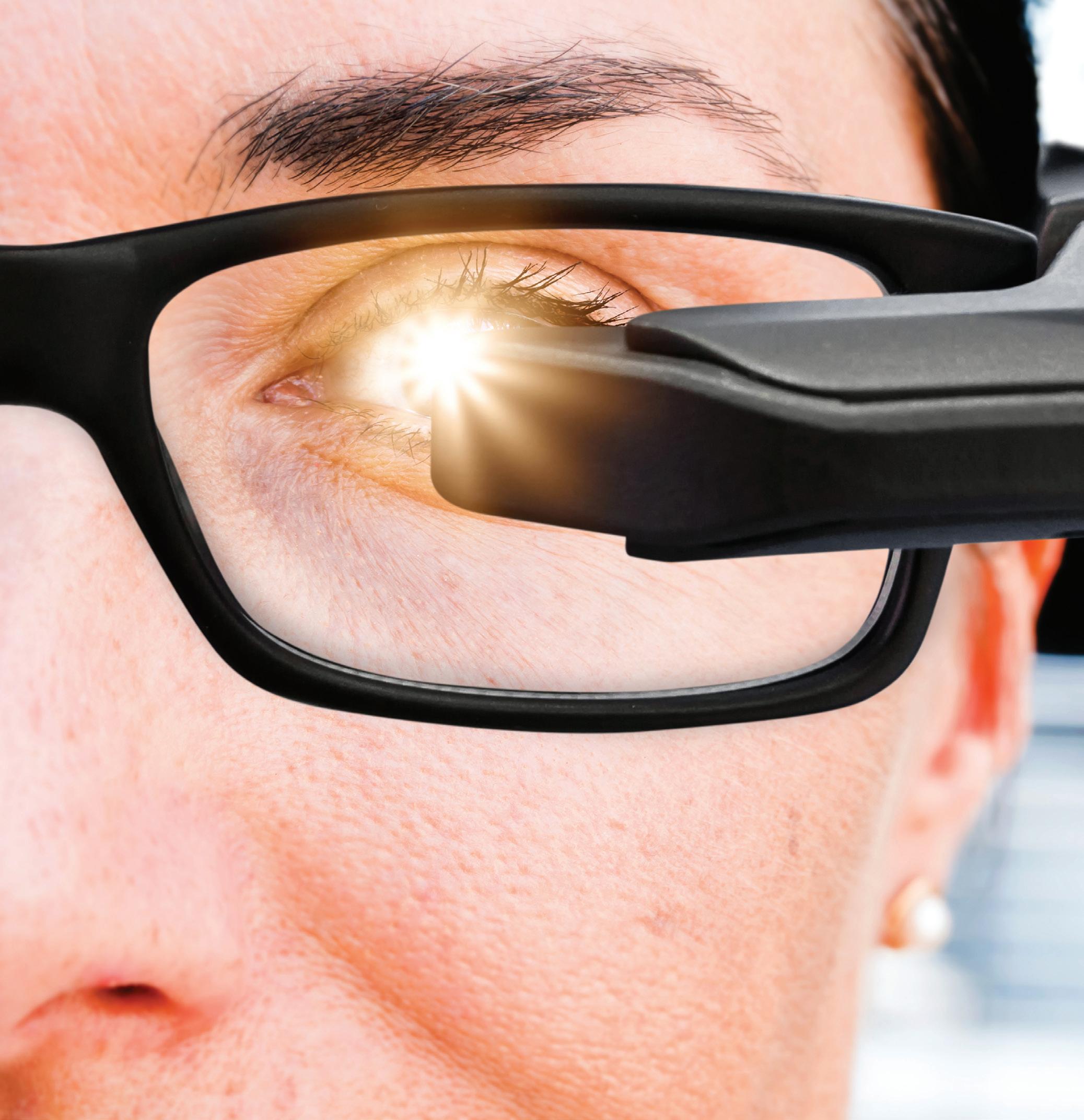
18 minute read
Virtual capabilities change practices for processing operations
Brian Van Valkenburg, Senior Manger Field Services and Training, Swagelok Company
Virtual site visits and training courses bring remote expertise to plants.
Connecting distant teams to solve local site issues at facilities has always presented logistical challenges. How can the team provide timely remote feedback? How soon can a full team of experts be onsite to address the issue? The same challenges have faced facilities as they collaborate with external suppliers providing services that have commonly required onsite visits. As virtual technology has become more advanced, companies are starting to leverage these capabilities to allow their teams to connect from different locations more effectively. Whether companies need field engineering surveys or proper training for their personnel, virtual technology is allowing them to accomplish these goals with lower costs and fewer scheduling conflicts. Not surprisingly, virtual site visits and training programs are becoming essential tools in helping facilities run more efficiently and effectively.
Virtual field engineering visits
Before virtual technology became popular, field engineering visits to plants required a significant amount of time and expense. A group of field engineers would visit a site to evaluate various systems and equipment and provide multiple perspectives on their operation. Bringing multiple engineers to the facility not only resulted in significant travel expenses but also disruptions to the normal work of a facility. During a virtual visit, only one field engineer is required to be onsite. Equipped with an augmented reality (AR) collaboration headset, that engineer can connect with other engineers around the world. This team of multiple engineers can then conduct a thorough evaluation of


During a virtual evaluation, the on-site engineer can share photos and videos with remote colleagues in real time so everyone can brainstorm solutions as a connected team.
©stock.adobe.com/au/zapp2photo
equipment and areas of concern throughout the facility just as they would if they were onsite inspecting the applications personally. The use of AR headsets has proven to provide the same level of value to organisations as onsite visits — and sometimes even better, as world-class experts may be able to be present on a virtual visit when they wouldn’t normally have been able to be at the facility for an in-person visit.
If field engineering teams are unable to visit a location to help with system troubleshooting and design challenges, or other matters, a remote format can be a welcome option. Though ideally there would be at least one field engineer onsite, it is also possible for facilities to use the AR headsets themselves, recording video while speaking with remote field engineers who provide real-time feedback. No matter how the virtual technology is deployed, virtual site visits allow facilities to minimise the amount of time their system issues go undiagnosed or unaddressed, while minimising travel-related costs and coordination of time.
Technology drives quality and efficiency
Though the importance of virtual site visits became even more critical as COVID-19 made onsite visits more difficult, the ongoing integration of AR technology has implications far beyond the pandemic. Being able to access worldwide experts virtually means troubleshooting capabilities can be broadened and consultations can perhaps be made available around the clock.
In addition, virtual site visits are ideal in situations in which inperson visits are difficult to manage, such as remote locations, offshore environments or other areas of restricted access. And since virtual visits are typically recorded, it allows field engineers to return to a visit using images and video to refresh their memories and ensure they do not miss anything.
The integration of AR technology into field engineering visits allows for faster deployment of resources and provides plants with access to a wider range of experts because the right specialists can be matched with the right challenges. Virtual visits also allow specialists to see the same thing at once without having to cycle specialists in and out of confined spaces. It also allows immediate collaboration between multiple experts to diagnose problems in real time.
Finally, virtual evaluations are also showing promise for getting end users quick recommendations to improve their facilities and systems — sometimes even the same day — thanks to the high level of collaboration the headsets enable.
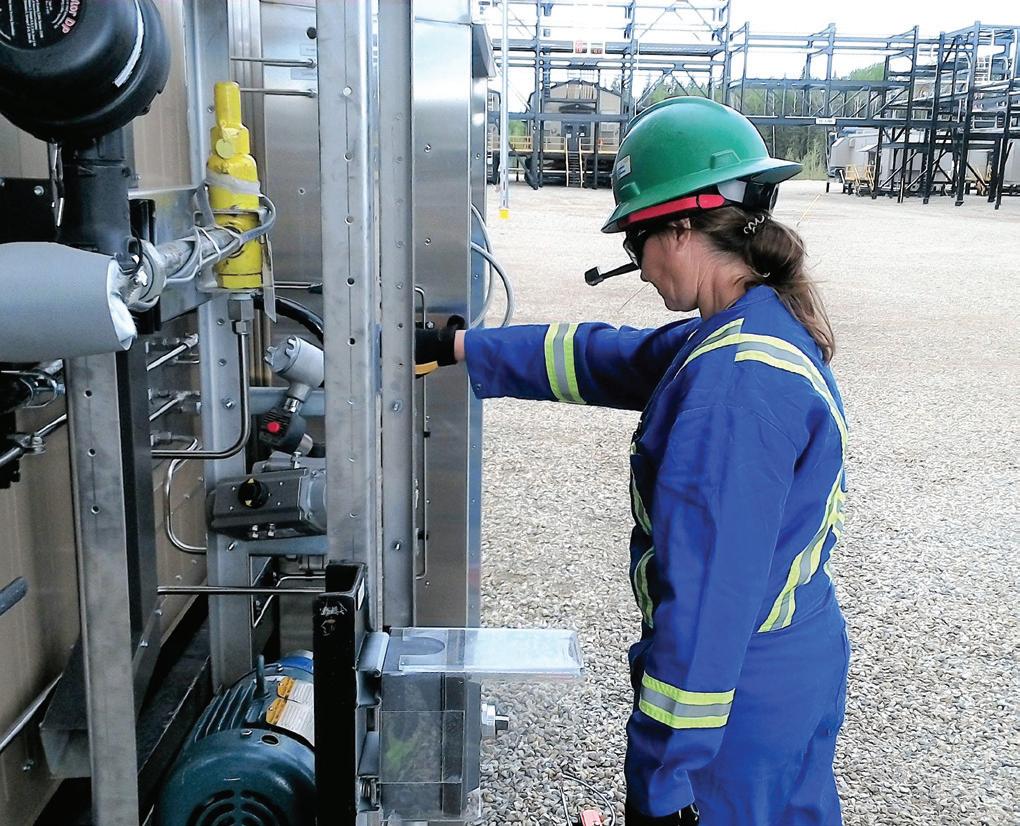
A field engineer wearing an AR headset inspects critical equipment at a chemical plant with the help of an engineering team watching a livestream video and providing remote support.
Virtual visit technology is not limited to providing field engineering visits. Companies can use the headsets for: • Virtual commissioning of systems and advising on the construction and testing of equipment: The AR headsets allow experts to be virtually present to provide oversight during key stages in the implementation of new facility systems, helping facilities avoid errors and perform optimised system integrations. Remote viewing also allows the organisation’s executives to experience processes they would not usually be able to witness. • Virtual witnessing of key procurement processes: Compliance teams can offer plants the opportunity to witness manufacturing and shipping practices that would usually require an onsite visit. • Virtual customer visits to manufacturing and fulfilment centres:
End users can also meet the people and see the processes behind the products and services they are purchasing, allowing them to take a tour of production facilities with an onsite tour guide.
Hosting virtual facility tours alongside relevant business meetings means manufacturers can provide the full experience of visiting their headquarters without requiring travel. It also allows manufacturers to reach more customers at once and expands the ability to meet with customers from around the world.
Virtual technology enables training
The expense and difficulty of travelling have not stopped essential work from continuing, which means training must continue as well. As an example, one of Australia’s leading gas suppliers, which is focused on safely and sustainably developing natural gas resources to power industries and households around the country, recently faced the issue of how to continue its critical training programs when in-person meetings were restricted.
The solution was to create an all-virtual training program that would allow employees to learn about proper safety protocols at their facilities without all gathering in person. Such virtual training programs offer a number of potential opportunities. Enhancing safety Focusing employees’ attention on even the most basic skills can be a welcome refresher to enhance their abilities and ensure they are up to speed and trained on the latest installation methods and operating procedures. That may mean incorporating specialised training programs into a facility’s normal activities, with the best programs featuring both practical and written assessments to engage trainees. Refreshing employees’ critical skills can reinforce best practices, helping facilities enhance safety across their operations. Such was the case for the Australian company, which deployed an extensive remote training program focused on tube fitting installation, inspection and tube bending to reduce the likelihood of loss of containment incidents — and thereby improve safety — at its five natural gas and LNG operations throughout the country. Improving employee engagement Taking the time to teach new skills and refresh old ones is an engaging experience for employees, even when training is done virtually. The key is to ensure the training is relevant to the employee’s role at the company and can help them improve outcomes in their daily jobs, while also offering room to grow and thrive in both their current and future roles. Increasing flexibility Moving to a virtual training model also introduces flexibility for employees, the benefits of which can include: • Smaller class sizes with greater opportunity for trainees to ask questions and build rapport with the instructor. • Attendance flexibility, as trainees can attend sessions on mobile devices and laptops either from their facilities or their own homes. • A greater blend of learning modes, which may include formal instruction and practical, hands-on training. Saving money Companies may also realise significant cost savings from virtual training — mainly because they no longer need to accommodate trainers onsite. This factor can help to significantly reduce per-trainee costs, while also allowing for the training to have a broader reach. Scaling rapidly To capitalise on growth potential, organisations must be able to quickly train staff with the skills required to implement new systems and operating procedures. Virtual training programs can help companies accomplish those training imperatives with greater flexibility and cost savings.
What the virtual revolution means for the future
As virtual meetings become the norm for both site visits and training, it is likely the technology will proliferate. Virtual site visits allow companies to get more detailed guidance on their facilities and systems. Specific experts can be accessed to provide additional expertise to site inspections and troubleshooting activities. In addition, virtual technology increases the ability of all parties to collaborate in real time, so problems do not go undiagnosed or uncorrected. The ability to solve problems more quickly saves downtime and repair costs in the process.
In addition, as corporations return to a ‘new normal’ during the continued pandemic, the advantages of holding virtual training sessions will remain. Whether it is providing flexibility to employees or saving costs for corporations, virtual training will offer opportunities for companies to reach a greater number of employees in a costeffective manner.
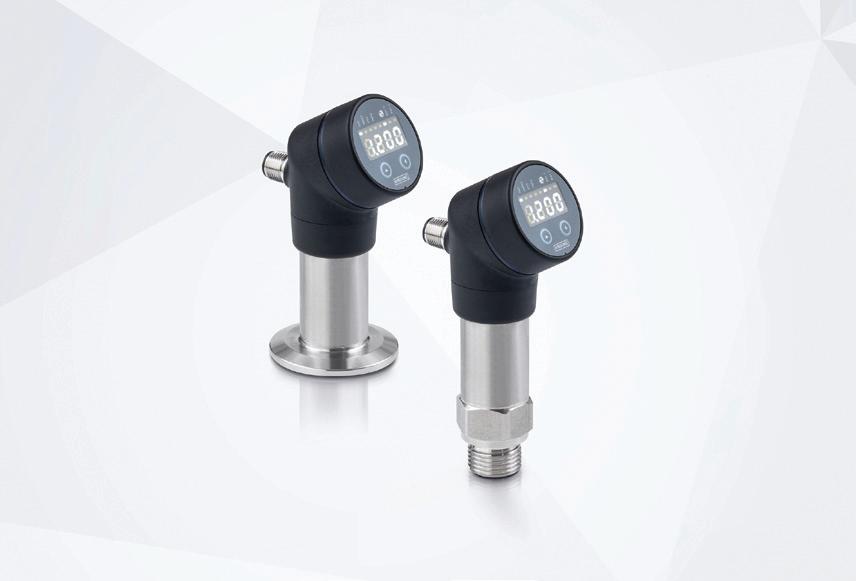
COMPACT PRESSURE SWITCHES
Krohne has introduced the OPTIBAR PSM 1010 and OPTIBAR PSM 2010 ultra-compact pressure switches for absolute and gauge pressure measurement in gases and liquids.
Both devices are aimed at basic automation applications such as hydrostatic level measurement in open tanks, dry-run protection of delivery pumps or pressure monitoring of compressors, hydraulic and pneumatic systems. Target industries include food and beverage, water and wastewater, environmental and OEM process equipment applications with restricted installation space.
The switches feature a 2-axis (multi-rotatable) display and adjustment module, a robust construction (IP67) and fully configurable communication outputs for all possible configurations: IO-Link and PNP/NPN as standard I/O, and 4–20 mA, 0–10 V or NPN/PNP as secondary output. Both devices offer high temperature stability due to digital compensation.
OPTIBAR PSM 1010 is suitable for liquids and gases from 0.1–600 bar (1.5–8700 psi) with process temperatures up to 125°C.
OPTIBAR PSM 2010 is aimed at hygienic applications in the food and beverage industry from 0.1–40 bar (4–580 psi) and a maximum temperature of +150°C. Its hygienic construction features a fully welded front-flush diaphragm to meet requirements in terms of crevice-free installation with several 3A-approved process connections.
KROHNE Australia Pty Ltd
www.krohne.com.au
FLEXIBLE HOSE ASSEMBLIES
AFLEX FaBLINE flexible hose assemblies offer a versatile hose solution that can be used throughout many different production processes. The hoses are said to carry up to twice the flow of similarly sized convoluted delivery hoses meaning that they can provide a faster, more efficient processing option.
The product’s low-friction, smooth bore construction means that it can dispense viscous fluids to precise levels, whereas rubber hoses may become blocked or even burst when tasked with this same application. The high flow rates offered also mean that the load and unload times will be shorter, reducing the cost of processing. The assemblies are offered in either EPDM or platinum cured silicone rubber and can have a range of end fittings attached. The hoses’ conductive liners mean that static build-up can be prevented during steam or air-drying processes. The PTFE liner tubes are chemically resistant to CIP, SIP and autoclave conditions to allow for efficient and complete sterilisation.
Watson-Marlow Fluid Technology Group
www.wmftg.com.au
VACUUM CONTROLLER
Atlas Copco has developed the HEX@ vacuum controller for Industry 4.0. It serves as an enhanced control centre for vacuum pumps and systems and is designed to ensure higher vacuum performance and functionality across a large range of applications.
Featuring increased connectivity and system integration, the company says it has a clean and intuitive user interface. Users access key data directly on the home screen and can access further settings and controls easily using the on-display menu. Relevant pump data is displayed quickly and the controller can be individually configured by users so that only selected values, such as discharge temperature, power consumption or inlet pressure, are displayed.
The communication options for HEX@ enabled pumps allow users to access the pumps remotely using smartphones, tablets, laptops or a PC; alternatively, access can be via the onboard HMI interface or a local device connected to the machine using wired or Wi-Fi-based connections.
Users can choose to connect fully to their local network and the cloud. The device will also support other communication protocols such as EtherNet/IP, EtherCAT, Profinet, Modbus/TCP, Profibus and OPC UA.
Atlas Copco Compressors Australia
www.atlascopco.com.au

CORIOLIS MASS FLOWMETERS
OVAL supplies three types of Coriolis mass flowmeters that are designed to be accurate, rugged and easy to use.
The ALTImass Type U is equipped with a transmitter providing self-diagnosis, a large size display and field reconfiguration capability using a touch panel. It is suitable for applications involving liquids and gases and requiring the measurement of extremely low flow, short-duration filling processes etc in addition to routine flowrate measurements.
The nominal size of the Type U is 250 mm and its flow range is 0 to 2,800,000 kg/h. Accuracy is ±0.1%RD for liquids and ±0.5%RD for gases, while the operating temperature range is from -200 to +200°C, with explosion-proof options available.
The vibration-resistant, single straight-tube model Type S is suitable for clean processes where the metered process fluid tends to build up or solidify, or where fast and positive process fluid replacement or draining of the pipeline is required.
The nominal size of the Type S is 10–80 mm, and it is suitable for liquid measurement in the flow range 0 to 91,800 kg/h. Accuracy is ±0.15%RD, and the operating temperature range is -40 to +13°C, with explosion-proof option.
Finally there is the compact general-purpose Type B for liquid measurement with a rainbow type flow tube. Nominal size is 10–50 mm, and the flow range is 0 to 96,000kg/h. Accuracy is ±0.2%RD (flow rate) and ±0.003 g/mL (density). The operating temperature range is -40 to +130°C, also with explosion-proof options.
Slentech Pty Ltd
www.slentech.com.au
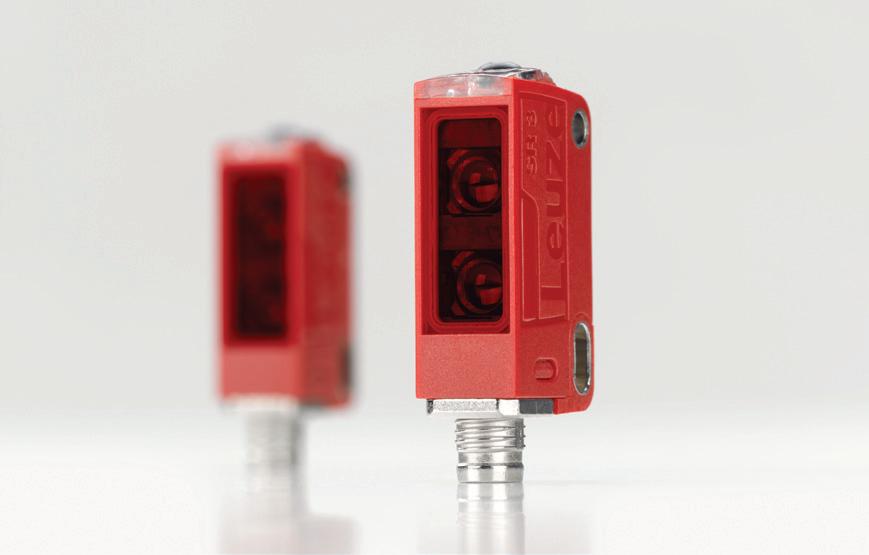
MULTIFUNCTIONAL SENSOR
The ODT 3C sensor from Leuze is designed to handle both measuring and switching tasks. The 2-in-1 solution is therefore suitable for a wide range of automated industrial applications.
With the ODT 3C from Leuze, only a single device is needed: the sensor can perform both switching and measuring tasks in the machine control, which the company says makes it an efficient and economical 2-in-1 solution.
The sensor transmits measurement values and diagnostic data via IO-Link. The data includes temperature values, warnings and signal quality. It features black-and-white behaviour (<±3 mm at 150 mm). The operating range can be easily adjusted via the teach button, line or IO-Link.
The sensor also offers functional reliability: active ambient light suppression prevents faulty switching, even when exposed to direct light from LED hall lighting systems. LEDs that are easily visible from all sides allow users to quickly read the status of the sensor. Two independent switching outputs and sensor models with warning output or a small light spot (pinpoint) round out the sensor’s functions. This enables plant operators to use the ODT 3C flexibly in a wide range of applications.
Leuze electronic Pty Ltd
www.leuze.com.au
ENTRY-LEVEL LINEAR ROBOT
igus is expanding its automation range with the drylin XXL room linear robot. The linear robot has an action radius of 2 x 2 x 1.5 m and is suitable for palletising applications of up to 10 kg. The robot includes a control system, and is said to be easy to set up and program without the help of a system integrator.
Many small and medium-sized companies shy away from getting started with automation because of expense and complexity, jeopardising competitiveness in the long term. A DIY robotics kit provides the opportunity to quickly and easily put a pick-and-place linear robot into operation for tasks related to palletising, sorting, labelling and quality inspection.
The DIY linear robot kit consists of two toothed belt axes and a toothed rack cantilever axis with stepper motors. While the default action range is 2 x 2 x 1.5 m, extensions up to 6 x 6 x 1.5 m are also possible. The package includes a switch cabinet, cables and energy chains as well as the igus Robot Control (iRC) control software, which provides a digital twin of the linear robot that can be used to define movements with a few clicks. igus sasy the system itself does not require any maintenance. The linear axes consist of corrosion-free aluminium and the carriages move via plain bearings made of high-performance plastic which, due to integrated solid lubricants, enable a low-friction dry operation without external lubricants for many years.
Treotham Automation Pty Ltd
www.treotham.com.au
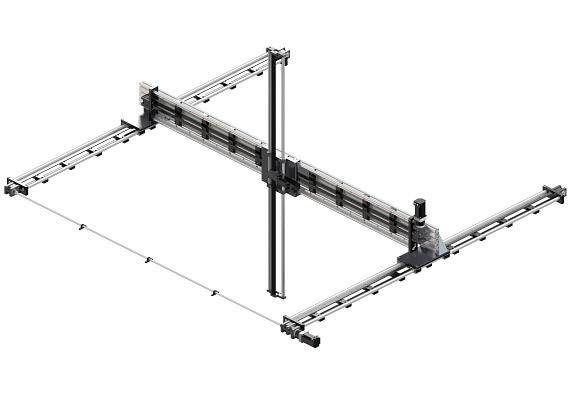
GIANT KAISHAN COMPRESSORS TO MEET AUSTRALIAN NICKEL DEMAND
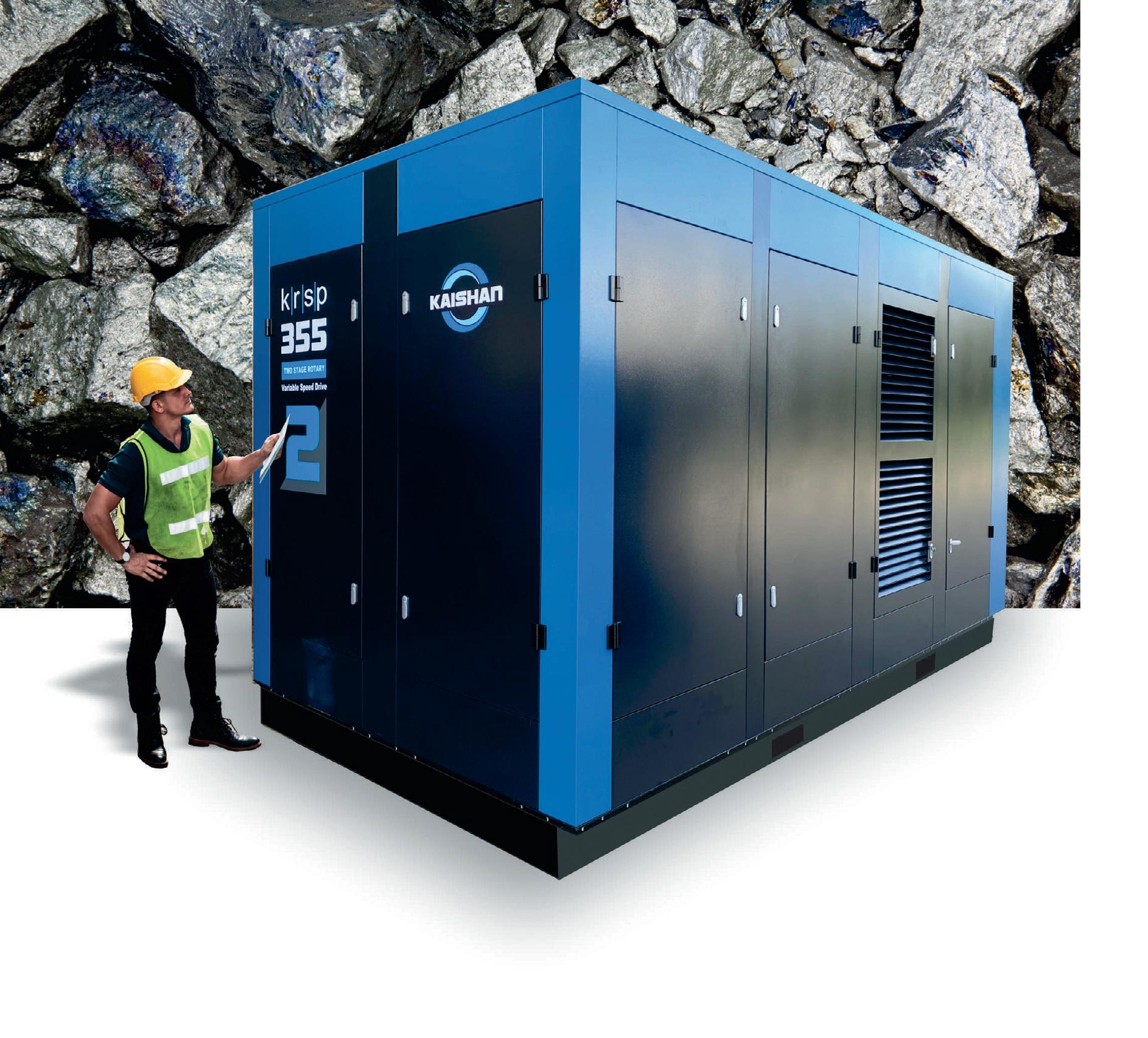
Australia is one of the world’s largest nickel producers with multi-billion dollar sales per annum.
With an ever increasing demand for nickel in the manufacture of stainless steel and more recently as a major component in lithium batteries to store electricity from wind and solar installations, as well as to power the electric vehicles of today and the future, the demand for nickel is set to grow dramatically. The sustainable production of nickel is also essential to meet this future demand as the customers purchasing EVs want to know that the inputs to the manufacturing of these vehicles are also sustainable.
Nickel sulphide is mined before being crushed and concentrated using nickel sulphide floatation technology. The concentrate is then dried and smelted into a granulated matte of 68% pure nickel product. The refinery process converts this base product to 99.8% pure nickel metal powder and briquettes for the local and export markets. Australian refineries will also need to meet a rapidly expanding local and global demand for 99.99% pure nickel sulphate.
To power mining and refinery processes required to meet this rapidly growing demand, superseded compressors are being replaced with Kaishan KRSP 2-stage rotary screw compressors with integral variable speed control.
These compressors employ advanced 2-stage and variable speed technology to each produce compressed air at a rate of 70m3/min at 10barg with a highly beneficial output to input energy ratio. The energy saving operation of these new-age compressors complements the green energy and sustainable production capabilities for Australia’s nickel refining processes.
Each compressor is 4350 x 2200 x 2580 in size and weighs 11,500 kg, and is specially built to handle the hot, dusty and harsh conditions of mining and heavy industrial applications. The compressors will be maintained and serviced by Kaishan partner company, Hoerbiger.
Kaishan Compressors, through their global design and manufacturing facilities, have the capability to design, produce and install custom compressed air solutions for every application. The company supplies a wide range of air compressors from heavy duty rotary screw models to compact compressors for a range of general and specialised applications.


Dairy heat exchanger meets tight spec for Burra Foods
The unit had to connect to plate heat exchangers in a tight physical space.
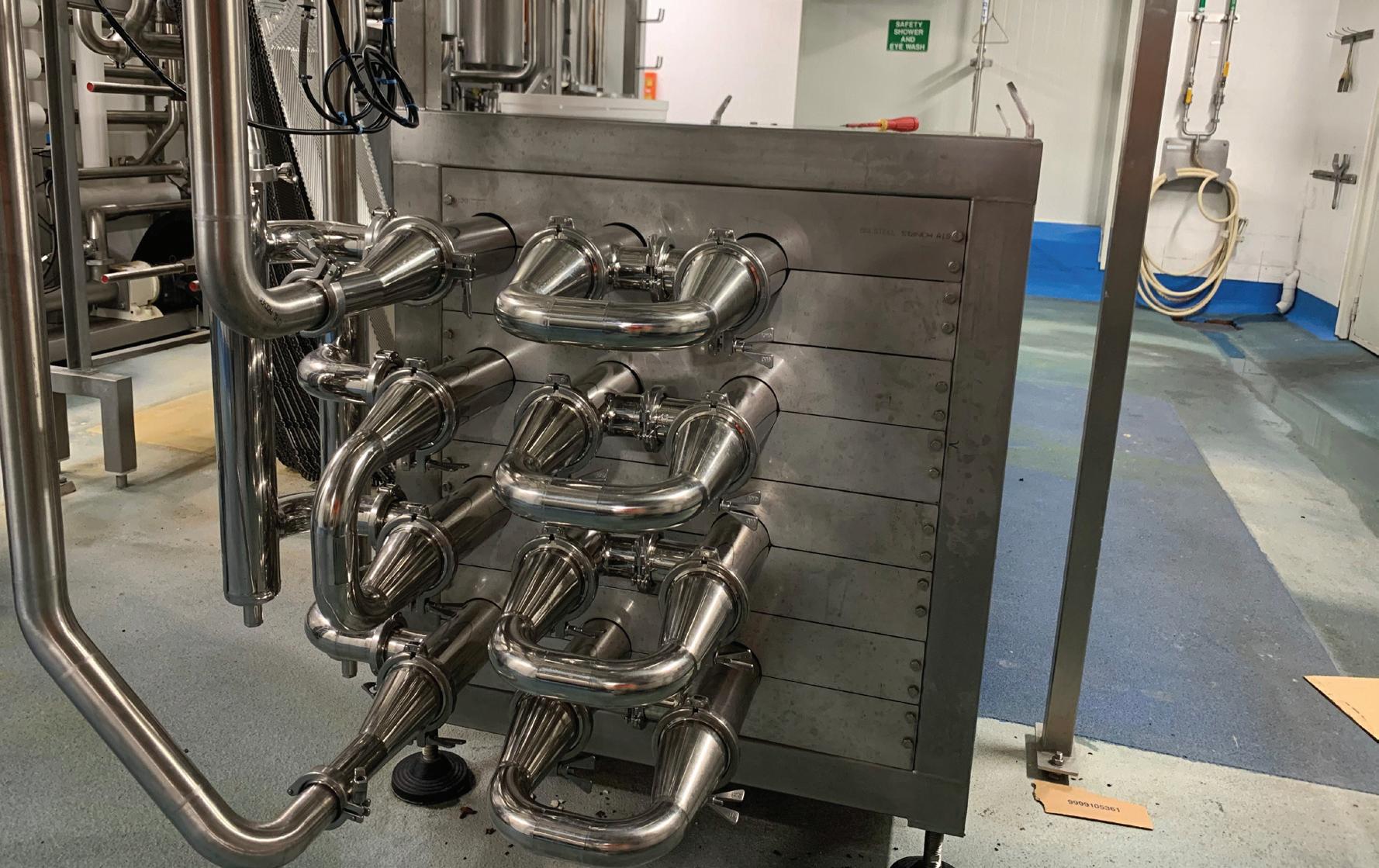
Burra Foods is a leading Australian dairy ingredient processor, producing value-added dairy products for the global food manufacturing market. An upgrade at their processing plant in Korumburra, Victoria, necessitated the use of a heat exchanger to warm frozen milk products, but existing building and infrastructure meant that the available space was severely limited.
The line in question produces skimmed milk concentrate and cream from frozen concentrates which are then thermalised and cooled to ambient processing temperatures. The required heat exchangers needed to raise the temperature of the product from -5 to 18°C prior to the final heater, which includes melting the frozen product. After this the product is then cooled from 10 to 5°C in the final cooler. Due to the consistency of the skimmed milk concentrate and cream the product is quite viscous, so the heat exchanger needed to resist fouling and provide good heat transfer performance, while also integrating with the plate heat exchangers used in the process in an extremely limited footprint.
The solution was an HRS MI Series corrugated tube heat exchanger, which provided the necessary heating and cooling requirements in the tight space available and also resulted in a small pressure drop, another important consideration for this installation. Following an initial enquiry at the end of 2019, the unit was installed in mid-2020, and it has exceeded performance expectations since final commissioning, with a production capacity of 5000 kg of product per hour.
“Other suppliers couldn’t match HRS’s offering in terms of tubular heat exchangers and the level of detail provided,” said Stuart Shattock, Process Engineering Manager at Burra Foods. “Once we placed the order, there was a slight delay due to COVID-19, but HRS managed to produce it as a rush order and the installation and commissioning was really smooth. In fact, they were able to accommodate a change to the process design partway through installation and make some improvements on the fly, which is great for a nimble and flexible food and beverage business like ourselves.
“There are two parts to the unit: the heater and the cooler. The heater has performed well and done exactly what we expected, while the cooler has actually done more than we expected. Overall, we are very happy with the product and the output from it.”
“HRS’s corrugated tube heat exchanger technology was required in order to prevent fouling from the thick cream element of the product,” added Chris Little, Australian Director at HRS Heat Exchangers. “The requirement for a heat exchanger with a small physical footprint meant that coming up with the final design was a challenge, but our engineering team rose to the occasion and provided a reliable solution that meets all of Burra Foods’ needs.”


